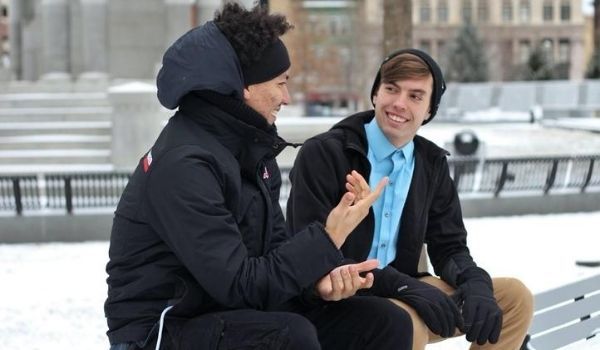8 Ways to Learn Dutch Fast
Categories: Education
Thank you to Talen Coach’s Albert Both for sharing different ways to learn Dutch fast!
Everyone wants to learn Dutch fast when they arrive in the Netherlands. But there’s no one size fits all solution.
Luckily, however, there are multiple ways to learn Dutch quickly! Albert Both, owner of Talen Coach, has taught Dutch to expats for over 15 years and understands the struggle.
“You don’t have to become a Dutch person,” he says, “just a more expanded version of you.” Albert has a few suggestions on how to learn Dutch quickly and confidently!
Set a Goal for Yourself
Albert often sees students trying to memorize the language, rather than immersing themselves in the culture.
“If you’re not really part of that natural environment,” he says, “then you’re having a less pleasant experience.” But if you set goals for yourself, you may find yourself understanding Dutch in no time!
And those goals don’t have to be difficult. In fact, they should be fun and practical! “If you start learning Dutch for boring things,” Albert says, “why would you do it?”
Set small, tangible goals in the beginning, like:
- Order your drinks in Dutch
- Give someone a compliment in Dutch
- Get through your shopping interactions without using English
- Read a menu without using Google translate
- Have a small interaction with your neighbor
Once you achieve these smaller goals, you can set larger goals for yourself.

Watch TV with Dutch subtitles
Is there a movie you could cite almost by heart? Or an episode of a series that you’ve seen a million times? Most media isn’t dubbed in Dutch, but try turning on the Dutch subtitles!
Alternatively, you can challenge yourself by muting the audio and only reading the subtitles to understand what’s happening.
And if you watch the news or videos about current events, you can also learn some new vocab words. You’re probably following news stories in your own language, so it can be helpful to listen and watch those same news stories in Dutch.
“Observe what is around you,” Albert recommends.
Listen to Dutch Radio
Listening comprehension can be the most challenging part of learning Dutch! And it’s especially challenging when people keep switching to English.
But when you listen to Dutch radio channels like Radio Veronica, you can hear Dutch non-stop! You can also learn colloquialisms or manners of speech. For example, a Dutch person may say “zeker” to acknowledge that they’ve heard you or agree with you.
It’s like how people say “yeah” or “mhm” while someone else is speaking as a way to acknowledge they’re listening. You won’t easily pick up these nuances in a classroom or from a book.
Don’t Speak English
Your audience is probably switching to English because they know it’s easier. But if you insist on speaking Dutch, they will appreciate your efforts even more than if you just gave up after trying one sentence.
“Most students are blocked in a creative way,” Albert says. When people need to say something, they try to translate their exact needs into Dutch. But more often than not, we don’t have that capability when we first learn a new language.
So instead of forming a perfect sentence, try to build one from the words you know. For example, if you don’t remember the word for breakfast, you can say “I eat eggs for not dinner and not lunch.”
It may sound weird, but it communicates what you’re trying to say, and helps you practice speaking. And maybe your audience will tell you what the word is for breakfast (onbijt).
Don’t give up just because you don’t feel like you can speak perfectly. How often do children construct a perfect sentence when they first learn to speak?

Read Children’s Books
Learning a language doesn’t have to be an academic experience. We try to learn Dutch the same way we learned everything else: in a classroom with exams and homework.
But we don’t naturally learn and absorb language that way! We seem to think it’s unacceptable to construct sentences like children because we aren’t children.
But no one comes out of the gate writing novels or delivering speeches. You have to accept that you may need to construct sentences like a child for a while.
It may feel silly to read books meant for children, but they can be a great introduction to simple grammar and vocabulary.
And that playful nature of your learning process can be helpful, too. Albert encourages students to let down their guard in order to learn. “A lot of learning happens automatically,” he says.
Albert recommends Vos en Haas – Het kijkwoordenboek van Vos en Haas, which is part of the larger Vos en Haas series by Sylvia Vanden Heede. And this English to Dutch dictionary Van Dale Basiswoordenboek Engels may be helpful as well.
Practice Whenever You Can
If you only ever watch instructional Youtube videos, you won’t learn how to use your Dutch!
Making mistakes can be embarrassing, but that’s part of any learning process. You have to be willing to make mistakes. “The Dutch feel little shame when they speak English to you,” Albert observes. So if they aren’t embarrassed, you don’t need to be either!
Trying your Dutch in different settings may be helpful, too. For example, you may feel more comfortable making mistakes talking to a friend than you would with the Albert Heijn cashier (or maybe vice versa).
Or, if you aren’t comfortable speaking with other people yet, make an effort to practice on your own. For example, when you eat breakfast, describe everything on your plate out loud, even if no one is listening.

Learn with a Friend
One of the challenges about going to free language meetups is that everyone is at completely different levels. So even if everyone welcomes you to the group, the people who speak the best will probably speak the most. And as a result, you may get left behind in the conversation and never really say a word.
But if you learn with a friend, you have someone who will struggle and succeed with you. You may learn at different paces, but they can also keep you accountable.
The only problem, however, is that if you’re both learning, you might repeat your mistakes if you don’t have someone to correct you!
Hire a Teacher
It may seem like the hardest way to learn Dutch, but hiring a teacher will keep you accountable! And with proper instruction, you may learn quicker and more efficiently than you realize.
Plus, a teacher can help you with the things that other strategies lack. They can correct you, explain things to you, and help you with listening comprehension.
And with Talen Coach, your learning experience won’t be like a stuffy classroom! “People think if they’re serious, they learn more, however, once you are playful you’ll learn faster, certainly if you know how to have outrageous fun with it” says Albert.
But intensity can be a key component to mastering Dutch. Immersing yourself and dedicating time to practicing Dutch will help you successfully learn the language fast.

Accept That It Will Take Time
If you want to learn Dutch as fast as possible, you need to be open to it, practice it regularly, and set goals for yourself. If you force yourself to learn Dutch for the sake of learning Dutch, it will be an uphill struggle.
“Dutch has to be different somehow, because otherwise, you’d pick it up automatically,” Albert says.
Sign up for Albert’s 7 Day Dutch Brainwash intensive course to start learning today!

Hi Albert! i’ve been learning Dutch for 16 months but i don’t live in The Netherlands, i live in the US. I have done all the things you mentioned in this article except reading children’s books. ( i have seen them online, but not handprint) I don’t have a lot of Dutch people by me so it gets hard sometimes. Besides all of the above mentioned which i have done already, what could you recommend me to move up from upper beginner to intermediate/lower advance? thank you.